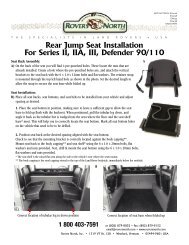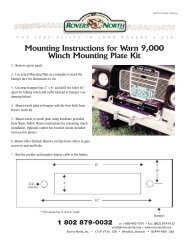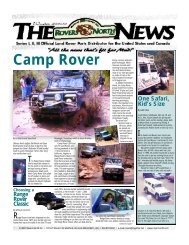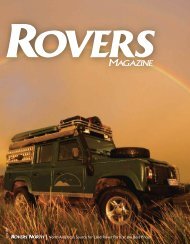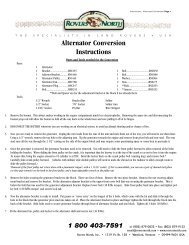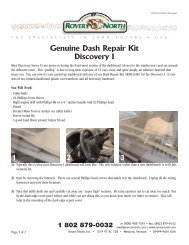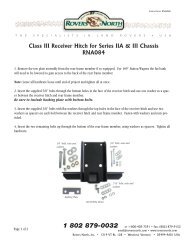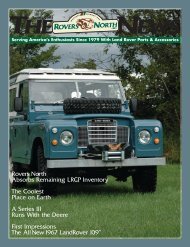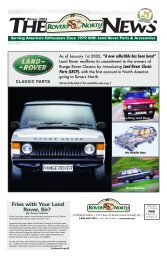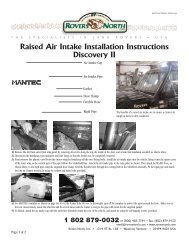Create successful ePaper yourself
Turn your PDF publications into a flip-book with our unique Google optimized e-Paper software.
<strong>to</strong> draw it <strong>to</strong> <strong>the</strong> side ties’ connecting points. After mounting <strong>the</strong><br />
windscreen rail, I connected <strong>the</strong> drain channel door post <strong>to</strong> <strong>the</strong> large<br />
“tabs” on <strong>the</strong> front hoop. I <strong>the</strong>n bolted <strong>the</strong> triangle-shaped corner<br />
brackets (Part No. 345821/22) <strong>to</strong> <strong>the</strong> gutter rails, leaving <strong>the</strong> nuts<br />
loose on <strong>the</strong> corner brackets. After tightening up <strong>the</strong> entire assembly,<br />
I added door seals <strong>to</strong> <strong>the</strong> drain channel door posts and <strong>to</strong> <strong>the</strong> gutter<br />
rails. This required <strong>the</strong> drilling of a lot of holes and strenuous use of<br />
<strong>the</strong> rivet gun.<br />
I also installed hoop brackets at <strong>the</strong> base of each hoop (Part No.<br />
304301), and I mounted front tie downs (Part No. 330578/79) <strong>to</strong> <strong>the</strong><br />
vehicle sides just beneath <strong>the</strong> front hoop. The tie downs require<br />
drilling two holes each and fur<strong>the</strong>r use of <strong>the</strong> rivet gun. Finally,<br />
I mounted two tie down staples <strong>to</strong> <strong>the</strong> windscreen rail and two <strong>to</strong> <strong>the</strong><br />
rear of <strong>the</strong> vehicle <strong>to</strong> tighten <strong>the</strong> canvas <strong>to</strong> <strong>the</strong> hoop set.<br />
I started at <strong>the</strong> front of <strong>the</strong> vehicle and looped <strong>the</strong> webbing strip<br />
on<strong>to</strong> <strong>the</strong> windscreen rail and gutter rail’s “teeth”. With <strong>the</strong> sides<br />
of <strong>the</strong> <strong>to</strong>p draped down, I tucked <strong>the</strong> edge of <strong>the</strong> canvas siding in<strong>to</strong><br />
<strong>the</strong> flange on <strong>the</strong> drain channel door post. I wrapped <strong>the</strong><br />
interior-mounted strap around <strong>the</strong> front hoop and fastened <strong>the</strong><br />
interior buckle.<br />
After draping <strong>the</strong> canvas down over <strong>the</strong> rear of <strong>the</strong> vehicle,<br />
I pulled <strong>the</strong> two long straps down and tied <strong>the</strong>m off with <strong>the</strong> two rear<br />
tie down staples. Inside <strong>the</strong> vehicle, I <strong>the</strong>n pulled <strong>the</strong> two long straps<br />
hanging down by <strong>the</strong> rear bulkhead <strong>to</strong>ward <strong>the</strong> windscreen rail and<br />
tightly tied <strong>the</strong>m off at <strong>the</strong> two tie down staples.<br />
I mounted two horseshoe-shaped rear tie downs (Part No.<br />
345699) over <strong>the</strong> tail lights for tying off and tightening <strong>the</strong> canvas with<br />
<strong>the</strong> four pre-cut lengths of rope included with <strong>the</strong> <strong>to</strong>p. While<br />
threading <strong>the</strong> rope through <strong>the</strong> canvas is not difficult, it <strong>to</strong>ok some<br />
patience. For <strong>the</strong> sleeve on <strong>the</strong> <strong>to</strong>p of <strong>the</strong> canvas’ rear flap, I taped<br />
<strong>the</strong> rope <strong>to</strong> <strong>the</strong> end of a broom handle, allowing me <strong>to</strong> “push” it<br />
through <strong>the</strong> sleeve. With <strong>the</strong> canvas on, I hooked <strong>the</strong> rope under <strong>the</strong><br />
side and rear hasps, respectively, and <strong>the</strong>n tied <strong>the</strong>m off at <strong>the</strong> rear tie<br />
downs over <strong>the</strong> tail lights.<br />
While it’s not essential, I plan <strong>to</strong> apply a healthy coating of<br />
Canvak <strong>to</strong> enhance <strong>the</strong> durability and waterproofing of my new<br />
purchase. I also plan <strong>to</strong> install some wooden dowels in<strong>to</strong> <strong>the</strong> canvas’<br />
sleeves <strong>to</strong> make <strong>the</strong> sides straighter and easier <strong>to</strong> roll up. While I like<br />
<strong>the</strong> traditional look of <strong>the</strong> rope, I will probably replace <strong>the</strong>m with<br />
some bungee cord making it easier <strong>to</strong> secure <strong>the</strong> canvas <strong>to</strong> <strong>the</strong><br />
vehicle, particularly in <strong>the</strong> wet. To help <strong>the</strong> <strong>to</strong>p retain its shape for a<br />
long time, it’s helpful <strong>to</strong> really cinch down <strong>the</strong> <strong>to</strong>p in wet wea<strong>the</strong>r and<br />
let it dry, tied down tightly.<br />
Needless <strong>to</strong> say, with my soft <strong>to</strong>p on, I am thoroughly enjoying <strong>the</strong><br />
cool spring wea<strong>the</strong>r. Not only is it breezy, but I can roll up <strong>the</strong> sides<br />
and still have shade. Of course, few vehicles draw more attention<br />
than a Series Rover with its soft <strong>to</strong>p down or sides rolled up.<br />
_______ ________<br />
11



